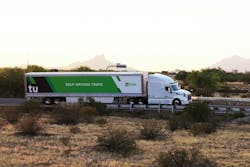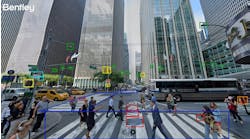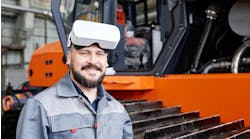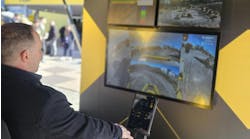By: Brian Wynne
COVID-19 has presented the world with tremendous challenges.
I am proud to represent one of the many industries that is working tirelessly to help address these difficulties and provide solutions so our society can continue to move forward even in the midst of a pandemic. As the leader of the Association for Unmanned Vehicle Systems International (AUVSI), the world's largest nonprofit organization dedicated to the advancement of unmanned systems and robotics, I have the privilege of seeing a broad cross-section of the industry, and the groundbreaking work being done by corporations and professionals from more than 60 countries. Our members span industry, government, and academia, including the defense, civil, and commercial markets across the air, maritime, and ground domains. Within those many sectors, tremendous progress is being made to advance unmanned systems and provide meaningful solutions for humanity.
In particular, managing an invisible, airborne virus has highlighted the need for safe and reliable contactless delivery and transport. As we continue living in this “new normal,” what has been made clear is that the unmanned systems industry recognized the challenges posed by COVID-19 early on, and immediately began to provide solutions through the advancement of technology. This includes drone deliveries of COVID-19 tests and personal delivery devices—or sidewalk bots—to deliver food and medical supplies.
We are also seeing tremendous advances in unmanned ground systems. Often referred to as autonomous vehicles (AVs), we are undergoing transformation from the testing labs to the streets. The technology is evolving at a rapid pace and certainly faster than the pace at which current regulatory and legislative environments operate. Yet, with a heightened emphasis on social distancing coupled with new pressures on supply chain logistics and delivery services, the demand for AVs has never been greater. This confluence of technology, societal needs, and regulatory shortcomings have kept my association, and the unmanned systems industry writ large, very busy.
As industry continues widespread operational testing of AVs—ranging from transit buses to food delivery bots to ride-share automobiles to semitrucks—we find ourselves turning a corner. There are fundamental elements of the way we live that will be impacted by the shift from human piloted vehicles to automated vehicles. As we move into the era of extensive Level 4 deployment and look forward to Level 5 full automation, we must work together to shape the future not only of our technology and AVs, but we also must be thinking about the broader impact AVs will have on society and how we can be a positive part of that change. The clarion call of the industry must revolve around safety, for it is this message that will be the linchpin towards increasing public trust in AVs, thereby leading to the state we all want which is increased adoption of this technology.
With more than 36,000 Americans killed in car accidents every year, AV technology represents the most promising step forward in decreasing traffic fatalities. Our industry must continue to conduct reliable and trustworthy research into autonomous vehicles, as these studies will be key in demonstrating the safety of this emerging technology to regulators, legislators, and the public alike. Widespread AV deployment holds so much potential, and AUVSI is dedicated to helping our industry see that potential delivered.
In fact, we are advocating at the local, state, and federal levels on behalf of unmanned ground systems and look forward to growing those efforts in 2021. Increasing the amount and quality of educational resources available to government officials lays at the crux of our goals, for we believe that a greater level of familiarity with AV technology will lead to smarter and more effective AV policy.
Local governing bodies are valuable entities in increasing AV testing and deployment, as they are the closest officials to the general public. It is imperative that industry works collaboratively with local leaders, and AUVSI is developing an engagement playbook geared towards that goal. We will be publishing best practices on creating partnerships between companies and government officials, along with how to proactively engage the public to work towards widespread technology acceptance.
A recent but increasingly widespread example of AV in various localities and states are autonomous personal delivery devices, or bots. Especially as we work to emerge from this pandemic, contactless delivery solutions are enriching many people’s lives, and the cities and states in support of this technology should be lauded for their foresight. AUVSI is engaging with various national associations of state and local leaders in conjunction with the companies that are successfully rolling out delivery bot technology, with the goal of uniting the two constituencies across the country.
This work will continue at the state level as AUVSI increases our interaction and collaboration with state legislators and regulators. Many states are leading the field in AV testing and deployment, and those officials and companies are to be lauded for their efforts. States like Arizona and Florida are unquestionable leaders in autonomous vehicle technology and offer valuable lessons in what does and does not work.
Advocacy at the state level will be strengthened by outreach and education geared towards DOT officials, representatives of the incoming Biden administration, and most importantly members of Congress and their staff. With renewed interest around federal AV legislation and the likelihood of a surface transportation bill in the 117th session, AUVSI will be leading discussions at those negotiating tables and working to amplify the needs of the unmanned industry in general, though certainly with an emphasis on unmanned ground vehicles.
We are working with the National Highway Traffic Safety Administration (NHTSA) on proposals for how the federal government should treat automated driving systems. Our goal for this effort is to form a federal regulatory system for driverless cars and related technologies that fosters innovation and creates public trust in autonomous vehicles. The existing patchwork of state standards has created uneven levels of deployment and advancement, which is unhelpful to businesses and confusing for the public. As a result, AUVSI plans to engage with the incoming Biden Department of Transportation to ensure that the creation of an autonomous vehicle framework is a foremost agency goal.
While the global pandemic has certainly made life more challenging in many ways, I am confident about the future of unmanned systems, their ability to address global and local challenges, and to keep us safe. The future of AVs is very strong, and with continued public-private collaboration, the possibilities are endless.
About The Author: Wynne is President & CEO of AUVSI.




